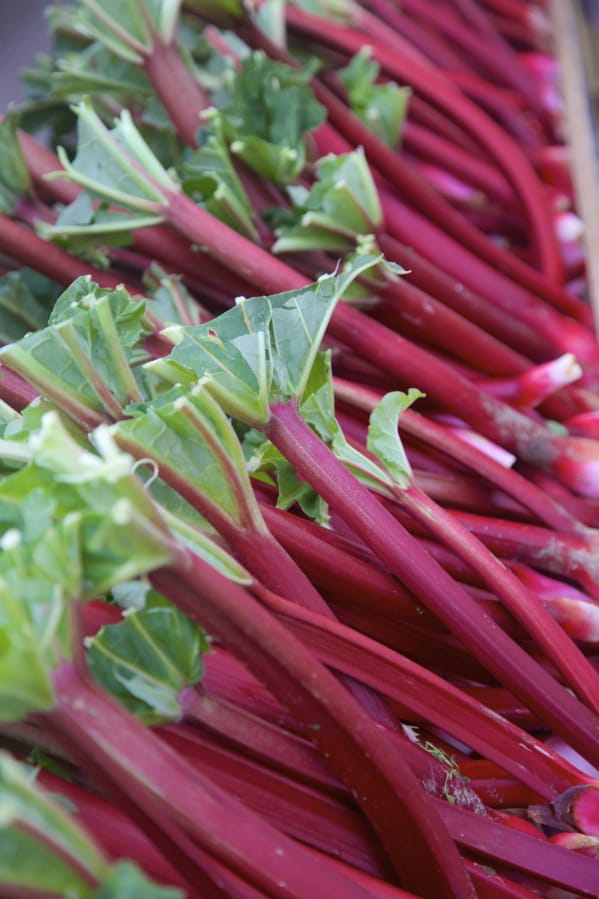Rhubarb — the rare gem of an early spring garden. As we slide into summer, rhubarb is still being harvested in the Pacific Northwest.
Rhubarb is a unique-tasting and hearty vegetable. Though classed as a vegetable, it is typically used in making pies and desserts. It has a tangy or sour taste, which gives it a distinct flavor that many people like. Some people like their desserts more on the tart side, but with enough sweetener, a rhubarb-based dessert can please the sweet-toothed person, too.
Rhubarb is typically sold as a root start called a bud or a crown, but it can be started from seeds, as well. It grows faster if you can get a bud or crown to start your plant with. If a friend has a rhubarb plant and is willing to give you a crown, it is best to start in early spring before any stalks begin to emerge. Split off a piece or pieces from the main crown (a shovel works best) and plant the new crown(s) about 1 inch below the surface of the ground. Rhubarb likes lots of compost and prefers well-drained soil to thrive. It is best to let the plant establish itself before harvest, so it is suggested that you wait until the second year to harvest the stalks. Rhubarb comes in both green and red/pink varieties. Even though they might be different colors, they have the same taste.
Harvesting should be done by gently twisting and pulling off a stalk from the base of the plant. Cut the leaves off and discard. The leaves contain oxalic acid and are considered poisonous. But don’t be afraid of them; just don’t consume them or give them to your farm animals.
Nutrition information
One cup of uncooked rhubarb contains 26 calories, 1.1 grams of protein, 0.2 grams of fat, 5.5 grams of carbohydrates, 2.2 grams of fiber and 1.3 grams of sugar. It also contains vitamin C, vitamin K, potassium, calcium and manganese.
This is one of the plants that the Oregon pioneers brought with them on the Oregon Trail. My family came west in the 1850s and brought their root starts of this plant. Rhubarb can grow and thrive in colder climates and was a welcome sight in early spring as it’s one of the first vegetables to come up through the ground. They would stew it with sweetener for a “spring tonic” to get the digestive system going, as the old-timers used to say. Stewed rhubarb is similar in texture and consistency to applesauce. My fondest memories are of my grandmother making rhubarb pies; she called it the Pie Plant.
To make spring tonic, cut 1 pound of rhubarb stalks into 1-inch cubes, add a few tablespoons of water and sugar (start with 1/2 cup and adjust to taste). Cook on low heat until at desired consistency (like applesauce). If you want a chunkier tonic, try not to stir it too much as it cooks. It can be served warm or cold, over cake, ice cream or just by itself.
Another family favorite is Rhubarb Jelly. You will need to extract the juice from the rhubarb. The easiest way to do this is to cut the stalks into 1-inch cubes and freeze for a few days. This breaks down the rhubarb, and it can be put into a steam juicer to extract the juice or by simmering in a saucepan until soft and straining it through a jelly bag. Don’t squeeze the pulp as it causes the jelly to be cloudy. Discard the pulp or sweeten and have as spring tonic. Then, follow the jelly recipe on your favorite pectin package.
Strawberry Rhubarb pie is a favorite of many and is super yummy!
For additional rhubarb recipes and serving suggestions, check out Chef Scotty’s Market Fresh Recipes at http://ext100.wsu.edu/clark/?p=8163.
Debra Basquez is a Clark County WSU Extension master food preserver. For additional recipes, food preservation and food safety information visit http://ext100.wsu.edu/clark/?p=1134. Have questions? Call the MFP Helpline: 360-397-6060 ext. 5366, or join Facebook Discussion Group “WSU Home Food Preservers — Clark County.”



